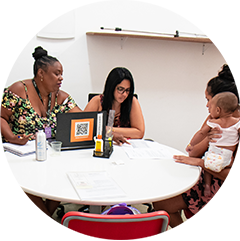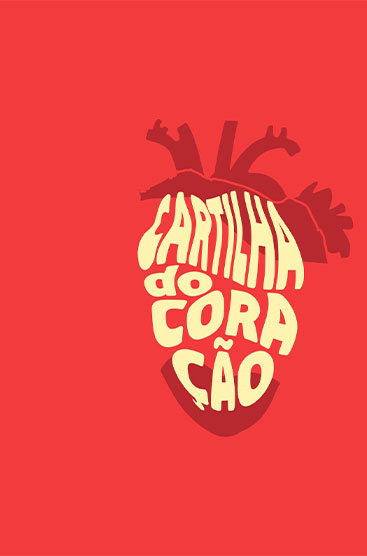28 YEARS OF MARÉ AS A NEIGHBORHOOD: REVISITING THE PAST, LOOKING AT THE PRESENT AND WORKING FOR THE FUTURE
By Jessica Pires and Julia Bruce
This is the column Who Makes Redes, a compilation of the stories of people who build our organization and who work hard every day to do what we do best: actions and projects for residents of Maré. Learn about these stories, trajectories, experiences and the history of Redes da Maré itself - and how this work and the challenges faced since the pandemic have transformed them.
On January 19, 1994, municipal law 2119/94 created the Maré neighborhood and grouped favelas that until then were not recognized as a unit. With more than 140,000 people in 16 favelas, if it were a city, Maré would be larger than 96% of Brazilian municipalities, according to data from Census Maré. Within the territory, residents have been telling the stories and particularities of each of the communities, such as the weavers André Galdino (34), Andreza Dionisio (23) and Shyrlei Rosendo (38). In this first edition of ‘Who Makes Redes’ in 2022, we celebrate 28 years of this recognition and look to our future: what do we want for Maré?
For you who were born and raised in Maré, what are your first memories of this territory?
Shyrlei: I was born in Parque União where I was raised by my grandparents. I have many memories, but the one that impressed me a lot was the urban transition process. I lived on a street that had no asphalt and only later was paved. What stands out to me is this idea of Maré. I was born on Rua São Pedro and grew up on Rua Tiradentes (in Parque União), where my aunt lived. They thought that anyone who lived beyond Dona Nevinha's store was low class, and I could only go there if I was accompanied by someone. It was a city within a city, I don't remember seeing wooden shacks in the Parque União. What marks me a lot is this issue of territorial organization, and how this is being appropriated and used over time, because people from the beginning of the PU did not mix much with those who lived at the end. The arrival of the Pre-College Course was important to expand the circulation of people who were from different favelas.
André: Me and Shyrlei have a very similar experience. I lived on Dona Nevinha's warehouse street, and my entire childhood was spent in Conquista and Sem Terra 1. I was even one of the first people to live there, but there was a certain prejudice. I have the memory of this structure that was not yet a city. But the interesting thing is that, somehow, I walked in the underworlds inside Parque União. For example, I had friends who lived near Avenida Brasil, and I had family who lived at the end of Maré. There came a time when I asked my parents: “Am I having this invented image in my head?”. I remember everything being water and walking on woods. I understood Conquista more like the middle class, and at the end of Maré I had an idea of being more needy. I only came to know other places, like Nova Holanda and Rubens Vaz, with the advent of the bridge.
Andreza:You are talking about circulating and this issue has always been very different for me… I am 23 years old; I am a child from Vila do João, I lived in the same house until I was 20, but my mother has lived in Maré since the stilt house days, in Baixa do Sapateiro, and my father is from Parque União. My parents were always very protective. My mother wouldn't let me go out on the street alone and my father also had a bar and always commented on things that happened. I studied at the border, so in my whole life I've been around a lot. From the age of 15 onwards, I stopped just passing through places and started to create bonds, to really enjoy the favela.
Shyrlei: I always wonder what happened. At the time there were many ghettos, today I see children circulating much more. How to take care of children and teenagers in Maré and ensure, in fact, that they circulate? It is necessary to have a network of minimum care. It was a very poor community, without leisure facilities. Today we have more, but people do not take advantage of the spaces. Perhaps children today play less in the street than we used to. I think these meeting spaces are fundamental, because it is on the street that your life begins, that you learn to deal with difference. Where are the children playing? How good is urbanization? And what kind of urbanization can be done? Because today the streets are for cars and motorcycles.
Andreza:Shyrlei is talking about that and I remember the bike path in Vila dos Pinheiros, how we lost that space. I always went to picnic there. I keep thinking that there is a process of understanding Maré as a whole. The internet has greatly enabled these meetings, this flow, such as the residents' Facebook group. I believe that now there are many more people from outside walking around Maré, and we feel safer.
How did you get to Redes da Maré?
Shyrlei: I was part of a mobilization sector, I even participated in Communication, I managed the newspaper's website, I was the coordinator of the Pre-College Course and then director. I was out of Redes for 3 years, but I returned to the Public Security and Access to Justice axis. I have experienced wars in the territory, movements against violence, and I believe that we have evolved a lot in the discussion about public security. But the challenge for all of Redes, which has more than 20 years of history, is to envision the future. What do we want for Maré in 10 years? And what are we going to do about it?
André: I also like to work with this perspective of the future: what do we want, where do we want to go and how can we achieve it? My relationship with Redes started a long time ago. I even had a writing class at CPV with Eliana Sousa. Redes was always the place of access, I would attend lectures, debates, events, seminars. I always felt part of Redes. In 2010, I started working as a community health agent and it was from there that this idea of walking in the territory expanded the way I understood the favela beyond just being a resident: I met several Marés within Maré. In 2016, I joined the Movimentos collective, which thinks about public security from the slums and talks with the greatest experts in the drug field, participating in events and actions in schools. From this connection, and because I am always present in Redes' actions, my arrival at the organization culminated in the creation of Normal Space, in 2018.
Andreza: Unlike Shyrlei and André, I had no relationship with Redes. I never knew what Redes was, I came to know when there was a campaign “Jovem Negro Vivo” (2015), with Amnesty International, and I felt like getting closer. When I was in college, an internship vacancy opened at the House of Women of Maré, I joined in 2018 and found myself. I created a great affection and it brought me a lot, but as I lived in Vila do João, I warned that the residents there did not have access to Redes and that we had to overcome these limits somehow. I then took on the responsibility of organizing the production of masks during the pandemic, and was hired for the service team at House of Women. Redes reconfigured my relationship with Maré, and today I also try to build perspectives and dream big, because it allows me to do that.
Territorial mobilization ended up becoming an important methodology in the work of Redes da Maré. Can you explain what this is, how it happens in Maré and why it became essential to think about actions with this strategy?
André: We were very attached to this idea of articulating with the territories and being present everywhere, carrying out actions with large proportions. But when I think about mobilization, it's the networks we create in order to draw attention, it's the permanent punctual mobilization on a daily basis, working on the idea of understanding how far this mobilization can go. It happens a lot on the micro, and when we put these pieces together, it generates the macro. I work a lot on the issue of accessibility, and mobilization is constant.
Shyrlei: People who come to us have individual demands, but the turning point is when you move from individual mobilizations to collective mobilizations, because only these can impact the structure. To mobilize is to move somewhere. And how do we help people to appropriate this, in the sense of belonging? It's also looking back and understanding our history, understanding what our mistakes were. It's the idea of how you look at the past to change the future.
Andreza: I very much agree with André that the importance of mobilization has this micro role in the territory. It's where things happen, it's in the place of planning, of influencing policies. I believe that mobilizing is a bridge, it's what it takes, it's putting it into practice.
Shyrlei: I think we have to be optimistic, but with good reason. We have the possibilities to do, but the end cannot be in itself. Perhaps we will gain from actual experiences, because it is a process of collective change, but it is not easy. Maré cannot see that the actions of individual demands are collective. Being an optimist and a dreamer is also looking at what life is all about.











